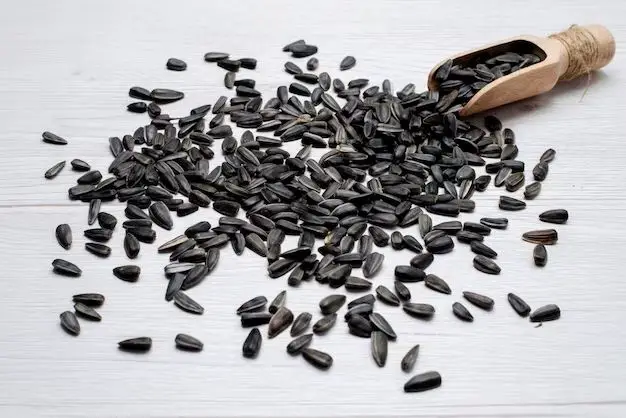Sunflower seeds are well known for their iconic striped hulls that range in color from black to white. However, some people may not know that the seeds inside can also vary in color, from the common yellow-green to a deep black. So what causes this difference, and what would happen if all sunflower seeds were black on the inside?
Page Contents
Why Are Most Sunflower Seeds Yellow-Green?
Most commercial sunflower seeds have a yellow-green kernel inside the hull. This color comes from chlorophyll, the green pigment that allows plants to photosynthesize sunlight into energy. Chlorophyll is abundant in actively growing plant tissues like young sunflower seeds, giving them their characteristic green hue.
As sunflower seeds mature and dry out, they lose some chlorophyll, shifting towards a more yellowish color. The final yellow-green tone is influenced by carotenoids – compounds that often give plants red, orange, and yellow colors. Different balances of chlorophyll and carotenoids lead to the range of colors we see in sunflower kernels.
What Causes Black Sunflower Seeds?
While most sunflowers produce yellow-green seeds, some varieties naturally have kernels that are black, gray, purple, red, or whitish.
This difference comes down to genetics. The black color is controlled by a dominant gene (B) that codes for anthocyanin pigments. Anthocyanins are also found in black beans, blueberries, purple cabbage, and other deeply colored foods. When the B gene is present in sunflowers, it leads to the production of dark anthocyanin pigments that turn the seeds black.
Some types of ornamental sunflowers are bred specifically for their exotic black seeds. Examples include the cultivars ‘Black Oil’, ‘Korean’, and ‘Panchita’. These striking black-seeded flowers are popular for gardens and floral arrangements.
How Would All-Black Sunflower Seeds Affect the Food Industry?
If all sunflower seeds suddenly turned black, it would cause some significant changes for food manufacturers.
Appearance of Foods
Many snack and bakery products use sunflower seeds and kernels for visual appeal. Black seeds would alter the look of foods like bread, granola, trail mixes, salads and more. Consumers attracted to the yellow-green flecks might be turned off by all-black seeds. However, black seeds could be used in darker foods like some breads, cookies and bars to create a different aesthetic.
Nutrition
Research suggests that black sunflower seeds may have slightly higher antioxidant levels than their yellow counterparts. However, both types have similar overall nutrition. So in terms of health value, black seeds would probably be equal or possibly better than regular yellow ones.
Production Costs
Since most sunflower processing equipment is designed for yellow seeds, an all-black crop could require updates to machines and techniques. Extra processing like dehulling may be needed to remove the black outer hulls from immature seeds. Handling black seeds during harvesting and transport could also drive up costs due to staining concerns.
| Color | Pros | Cons |
|---|---|---|
| Yellow | – Familiar appearance – Works with existing production/processing – Lower cost to produce |
– Lower antioxidant levels |
| Black | – Unique/novel appearance – Potentially higher antioxidants |
– Could stain equipment and hands – May turn off some consumers – Higher production costs |
How Would the Switch to Black Affect Growers?
For farmers who grow sunflowers, a sudden change to all-black seeds could have some complex effects.
Lower Demand from Food Industry
As mentioned, many food companies select standard yellow sunflower seeds for their appearance in snacks and baked goods. A switch to black seeds could decrease demand from these large-scale buyers, lowering crop prices.
Increased Popularity with Home Gardeners
While disliked by some food companies, black sunflower seeds would likely gain popularity among home gardeners. The exotic black flowers would stand out in any garden. This could lead more small-scale growers to plant black sunflower varieties, partially offsetting reductions from large food buyers.
Harvesting and Storage Challenges
Farmers would need to modify techniques to handle staining from black seed hulls during harvesting and transport. Special storage conditions may be needed to prevent damage to the black seeds. Some equipment adjustments could also be required. Overall costs would likely increase.
Potential for New Markets
While the food industry may move away from black sunflowers, it could open doors to alternative markets. The black seeds have a striking appearance when used whole in potpourri, floral arrangements and bird feeders. farms could consider relationships with crafts, gifts and décor companies looking for exotic black sunflowers.
Conclusion
A sudden shift to solid black sunflower seeds would certainly cause some significant ripples through the sunflower industry. There would be both advantages and challenges for food manufacturers and growers. While the classic yellow sunflower is unlikely to disappear anytime soon, black hybrids will likely continue gaining popularity thanks to their visual appeal. Whether used for snacking, baking or simple beauty, sunflowers will remain one of the world’s most beloved and versatile flowers.
